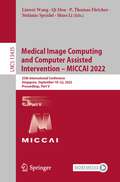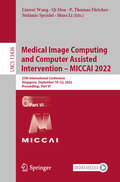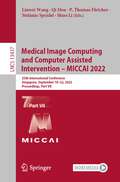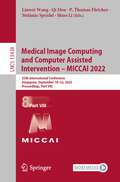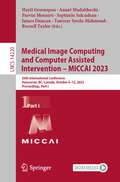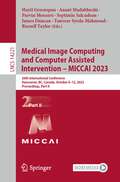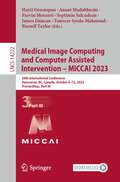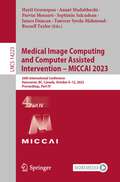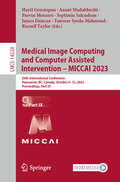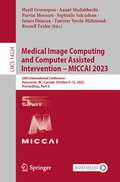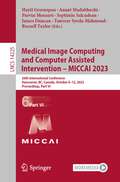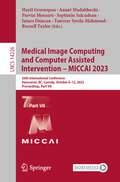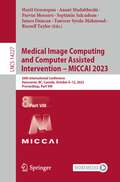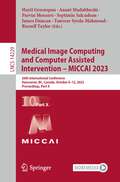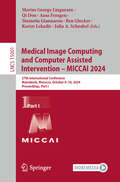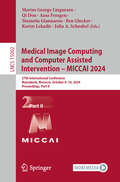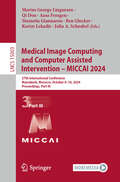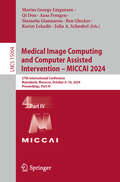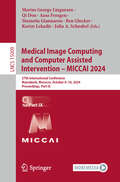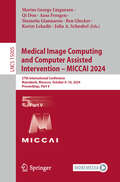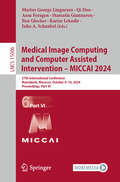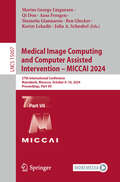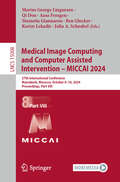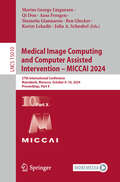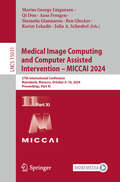- Table View
- List View
Medical Image Computing and Computer Assisted Intervention – MICCAI 2022: 25th International Conference, Singapore, September 18–22, 2022, Proceedings, Part V (Lecture Notes in Computer Science #13435)
by Shuo Li Stefanie Speidel Qi Dou Linwei Wang P. Thomas FletcherThe eight-volume set LNCS 13431, 13432, 13433, 13434, 13435, 13436, 13437, and 13438 constitutes the refereed proceedings of the 25th International Conference on Medical Image Computing and Computer-Assisted Intervention, MICCAI 2022, which was held in Singapore in September 2022.The 574 revised full papers presented were carefully reviewed and selected from 1831 submissions in a double-blind review process. The papers are organized in the following topical sections:Part I: Brain development and atlases; DWI and tractography; functional brain networks; neuroimaging; heart and lung imaging; dermatology;Part II: Computational (integrative) pathology; computational anatomy and physiology; ophthalmology; fetal imaging;Part III: Breast imaging; colonoscopy; computer aided diagnosis;Part IV: Microscopic image analysis; positron emission tomography; ultrasound imaging; video data analysis; image segmentation I;Part V: Image segmentation II; integration of imaging with non-imaging biomarkers;Part VI: Image registration; image reconstruction;Part VII: Image-Guided interventions and surgery; outcome and disease prediction; surgical data science; surgical planning and simulation; machine learning – domain adaptation and generalization;Part VIII: Machine learning – weakly-supervised learning; machine learning – model interpretation; machine learning – uncertainty; machine learning theory and methodologies.
Medical Image Computing and Computer Assisted Intervention – MICCAI 2022: 25th International Conference, Singapore, September 18–22, 2022, Proceedings, Part VI (Lecture Notes in Computer Science #13436)
by Shuo Li Stefanie Speidel Qi Dou Linwei Wang P. Thomas FletcherThe eight-volume set LNCS 13431, 13432, 13433, 13434, 13435, 13436, 13437, and 13438 constitutes the refereed proceedings of the 25th International Conference on Medical Image Computing and Computer-Assisted Intervention, MICCAI 2022, which was held in Singapore in September 2022.The 574 revised full papers presented were carefully reviewed and selected from 1831 submissions in a double-blind review process. The papers are organized in the following topical sections:Part I: Brain development and atlases; DWI and tractography; functional brain networks; neuroimaging; heart and lung imaging; dermatology;Part II: Computational (integrative) pathology; computational anatomy and physiology; ophthalmology; fetal imaging;Part III: Breast imaging; colonoscopy; computer aided diagnosis;Part IV: Microscopic image analysis; positron emission tomography; ultrasound imaging; video data analysis; image segmentation I;Part V: Image segmentation II; integration of imaging with non-imaging biomarkers;Part VI: Image registration; image reconstruction;Part VII: Image-Guided interventions and surgery; outcome and disease prediction; surgical data science; surgical planning and simulation; machine learning – domain adaptation and generalization;Part VIII: Machine learning – weakly-supervised learning; machine learning – model interpretation; machine learning – uncertainty; machine learning theory and methodologies.
Medical Image Computing and Computer Assisted Intervention – MICCAI 2022: 25th International Conference, Singapore, September 18–22, 2022, Proceedings, Part VII (Lecture Notes in Computer Science #13437)
by Shuo Li Stefanie Speidel Qi Dou Linwei Wang P. Thomas FletcherThe eight-volume set LNCS 13431, 13432, 13433, 13434, 13435, 13436, 13437, and 13438 constitutes the refereed proceedings of the 25th International Conference on Medical Image Computing and Computer-Assisted Intervention, MICCAI 2022, which was held in Singapore in September 2022.The 574 revised full papers presented were carefully reviewed and selected from 1831 submissions in a double-blind review process. The papers are organized in the following topical sections:Part I: Brain development and atlases; DWI and tractography; functional brain networks; neuroimaging; heart and lung imaging; dermatology;Part II: Computational (integrative) pathology; computational anatomy and physiology; ophthalmology; fetal imaging;Part III: Breast imaging; colonoscopy; computer aided diagnosis;Part IV: Microscopic image analysis; positron emission tomography; ultrasound imaging; video data analysis; image segmentation I;Part V: Image segmentation II; integration of imaging with non-imaging biomarkers;Part VI: Image registration; image reconstruction;Part VII: Image-Guided interventions and surgery; outcome and disease prediction; surgical data science; surgical planning and simulation; machine learning – domain adaptation and generalization;Part VIII: Machine learning – weakly-supervised learning; machine learning – model interpretation; machine learning – uncertainty; machine learning theory and methodologies.
Medical Image Computing and Computer Assisted Intervention – MICCAI 2022: 25th International Conference, Singapore, September 18–22, 2022, Proceedings, Part VIII (Lecture Notes in Computer Science #13438)
by Shuo Li Stefanie Speidel Qi Dou Linwei Wang P. Thomas FletcherThe eight-volume set LNCS 13431, 13432, 13433, 13434, 13435, 13436, 13437, and 13438 constitutes the refereed proceedings of the 25th International Conference on Medical Image Computing and Computer-Assisted Intervention, MICCAI 2022, which was held in Singapore in September 2022.The 574 revised full papers presented were carefully reviewed and selected from 1831 submissions in a double-blind review process. The papers are organized in the following topical sections:Part I: Brain development and atlases; DWI and tractography; functional brain networks; neuroimaging; heart and lung imaging; dermatology;Part II: Computational (integrative) pathology; computational anatomy and physiology; ophthalmology; fetal imaging;Part III: Breast imaging; colonoscopy; computer aided diagnosis;Part IV: Microscopic image analysis; positron emission tomography; ultrasound imaging; video data analysis; image segmentation I;Part V: Image segmentation II; integration of imaging with non-imaging biomarkers;Part VI: Image registration; image reconstruction;Part VII: Image-Guided interventions and surgery; outcome and disease prediction; surgical data science; surgical planning and simulation; machine learning – domain adaptation and generalization;Part VIII: Machine learning – weakly-supervised learning; machine learning – model interpretation; machine learning – uncertainty; machine learning theory and methodologies.
Medical Image Computing and Computer Assisted Intervention – MICCAI 2023: 26th International Conference, Vancouver, BC, Canada, October 8–12, 2023, Proceedings, Part I (Lecture Notes in Computer Science #14220)
by James Duncan Tanveer Syeda-Mahmood Hayit Greenspan Anant Madabhushi Russell Taylor Parvin Mousavi Septimiu SalcudeanThe ten-volume set LNCS 14220, 14221, 14222, 14223, 14224, 14225, 14226, 14227, 14228, and 14229 constitutes the refereed proceedings of the 26th International Conference on Medical Image Computing and Computer-Assisted Intervention, MICCAI 2023, which was held in Vancouver, Canada, in October 2023.The 730 revised full papers presented were carefully reviewed and selected from a total of 2250 submissions. The papers are organized in the following topical sections: Part I: Machine learning with limited supervision and machine learning – transfer learning; Part II: Machine learning – learning strategies; machine learning – explainability, bias, and uncertainty; Part III: Machine learning – explainability, bias and uncertainty; image segmentation; Part IV: Image segmentation; Part V: Computer-aided diagnosis; Part VI: Computer-aided diagnosis; computational pathology; Part VII: Clinical applications – abdomen; clinical applications – breast; clinical applications – cardiac; clinical applications – dermatology; clinical applications – fetal imaging; clinical applications – lung; clinical applications – musculoskeletal; clinical applications – oncology; clinical applications – ophthalmology; clinical applications – vascular; Part VIII: Clinical applications – neuroimaging; microscopy; Part IX: Image-guided intervention, surgical planning, and data science; Part X: Image reconstruction and image registration.
Medical Image Computing and Computer Assisted Intervention – MICCAI 2023: 26th International Conference, Vancouver, BC, Canada, October 8–12, 2023, Proceedings, Part II (Lecture Notes in Computer Science #14221)
by James Duncan Tanveer Syeda-Mahmood Hayit Greenspan Anant Madabhushi Russell Taylor Parvin Mousavi Septimiu SalcudeanThe ten-volume set LNCS 14220, 14221, 14222, 14223, 14224, 14225, 14226, 14227, 14228, and 14229 constitutes the refereed proceedings of the 26th International Conference on Medical Image Computing and Computer-Assisted Intervention, MICCAI 2023, which was held in Vancouver, Canada, in October 2023.The 730 revised full papers presented were carefully reviewed and selected from a total of 2250 submissions. The papers are organized in the following topical sections: Part I: Machine learning with limited supervision and machine learning – transfer learning; Part II: Machine learning – learning strategies; machine learning – explainability, bias, and uncertainty; Part III: Machine learning – explainability, bias and uncertainty; image segmentation; Part IV: Image segmentation; Part V: Computer-aided diagnosis; Part VI: Computer-aided diagnosis; computational pathology; Part VII: Clinical applications – abdomen; clinical applications – breast; clinical applications – cardiac; clinical applications – dermatology; clinical applications – fetal imaging; clinical applications – lung; clinical applications – musculoskeletal; clinical applications – oncology; clinical applications – ophthalmology; clinical applications – vascular; Part VIII: Clinical applications – neuroimaging; microscopy; Part IX: Image-guided intervention, surgical planning, and data science; Part X: Image reconstruction and image registration.
Medical Image Computing and Computer Assisted Intervention – MICCAI 2023: 26th International Conference, Vancouver, BC, Canada, October 8–12, 2023, Proceedings, Part III (Lecture Notes in Computer Science #14222)
by James Duncan Tanveer Syeda-Mahmood Hayit Greenspan Anant Madabhushi Russell Taylor Parvin Mousavi Septimiu SalcudeanThe ten-volume set LNCS 14220, 14221, 14222, 14223, 14224, 14225, 14226, 14227, 14228, and 14229 constitutes the refereed proceedings of the 26th International Conference on Medical Image Computing and Computer-Assisted Intervention, MICCAI 2023, which was held in Vancouver, Canada, in October 2023.The 730 revised full papers presented were carefully reviewed and selected from a total of 2250 submissions. The papers are organized in the following topical sections: Part I: Machine learning with limited supervision and machine learning – transfer learning; Part II: Machine learning – learning strategies; machine learning – explainability, bias, and uncertainty; Part III: Machine learning – explainability, bias and uncertainty; image segmentation; Part IV: Image segmentation; Part V: Computer-aided diagnosis; Part VI: Computer-aided diagnosis; computational pathology; Part VII: Clinical applications – abdomen; clinical applications – breast; clinical applications – cardiac; clinical applications – dermatology; clinical applications – fetal imaging; clinical applications – lung; clinical applications – musculoskeletal; clinical applications – oncology; clinical applications – ophthalmology; clinical applications – vascular; Part VIII: Clinical applications – neuroimaging; microscopy; Part IX: Image-guided intervention, surgical planning, and data science; Part X: Image reconstruction and image registration.
Medical Image Computing and Computer Assisted Intervention – MICCAI 2023: 26th International Conference, Vancouver, BC, Canada, October 8–12, 2023, Proceedings, Part IV (Lecture Notes in Computer Science #14223)
by James Duncan Tanveer Syeda-Mahmood Hayit Greenspan Anant Madabhushi Russell Taylor Parvin Mousavi Septimiu SalcudeanThe ten-volume set LNCS 14220, 14221, 14222, 14223, 14224, 14225, 14226, 14227, 14228, and 14229 constitutes the refereed proceedings of the 26th International Conference on Medical Image Computing and Computer-Assisted Intervention, MICCAI 2023, which was held in Vancouver, Canada, in October 2023.The 730 revised full papers presented were carefully reviewed and selected from a total of 2250 submissions. The papers are organized in the following topical sections: Part I: Machine learning with limited supervision and machine learning – transfer learning; Part II: Machine learning – learning strategies; machine learning – explainability, bias, and uncertainty; Part III: Machine learning – explainability, bias and uncertainty; image segmentation; Part IV: Image segmentation; Part V: Computer-aided diagnosis; Part VI: Computer-aided diagnosis; computational pathology; Part VII: Clinical applications – abdomen; clinical applications – breast; clinical applications – cardiac; clinical applications – dermatology; clinical applications – fetal imaging; clinical applications – lung; clinical applications – musculoskeletal; clinical applications – oncology; clinical applications – ophthalmology; clinical applications – vascular; Part VIII: Clinical applications – neuroimaging; microscopy; Part IX: Image-guided intervention, surgical planning, and data science; Part X: Image reconstruction and image registration.
Medical Image Computing and Computer Assisted Intervention – MICCAI 2023: 26th International Conference, Vancouver, BC, Canada, October 8–12, 2023, Proceedings, Part IX (Lecture Notes in Computer Science #14228)
by James Duncan Tanveer Syeda-Mahmood Hayit Greenspan Anant Madabhushi Russell Taylor Parvin Mousavi Septimiu SalcudeanThe ten-volume set LNCS 14220, 14221, 14222, 14223, 14224, 14225, 14226, 14227, 14228, and 14229 constitutes the refereed proceedings of the 26th International Conference on Medical Image Computing and Computer-Assisted Intervention, MICCAI 2023, which was held in Vancouver, Canada, in October 2023. The 730 revised full papers presented were carefully reviewed and selected from a total of 2250 submissions. The papers are organized in the following topical sections: Part I: Machine learning with limited supervision and machine learning – transfer learning; Part II: Machine learning – learning strategies; machine learning – explainability, bias, and uncertainty; Part III: Machine learning – explainability, bias and uncertainty; image segmentation; Part IV: Image segmentation; Part V: Computer-aided diagnosis; Part VI: Computer-aided diagnosis; computational pathology; Part VII: Clinical applications – abdomen; clinical applications – breast; clinical applications – cardiac; clinical applications – dermatology; clinical applications – fetal imaging; clinical applications – lung; clinical applications – musculoskeletal; clinical applications – oncology; clinical applications – ophthalmology; clinical applications – vascular; Part VIII: Clinical applications – neuroimaging; microscopy; Part IX: Image-guided intervention, surgical planning, and data science; Part X: Image reconstruction and image registration.
Medical Image Computing and Computer Assisted Intervention – MICCAI 2023: 26th International Conference, Vancouver, BC, Canada, October 8–12, 2023, Proceedings, Part V (Lecture Notes in Computer Science #14224)
by James Duncan Tanveer Syeda-Mahmood Hayit Greenspan Anant Madabhushi Russell Taylor Parvin Mousavi Septimiu SalcudeanThe ten-volume set LNCS 14220, 14221, 14222, 14223, 14224, 14225, 14226, 14227, 14228, and 14229 constitutes the refereed proceedings of the 26th International Conference on Medical Image Computing and Computer-Assisted Intervention, MICCAI 2023, which was held in Vancouver, Canada, in October 2023. The 730 revised full papers presented were carefully reviewed and selected from a total of 2250 submissions. The papers are organized in the following topical sections: Part I: Machine learning with limited supervision and machine learning – transfer learning; Part II: Machine learning – learning strategies; machine learning – explainability, bias, and uncertainty; Part III: Machine learning – explainability, bias and uncertainty; image segmentation; Part IV: Image segmentation; Part V: Computer-aided diagnosis; Part VI: Computer-aided diagnosis; computational pathology; Part VII: Clinical applications – abdomen; clinical applications – breast; clinical applications – cardiac; clinical applications – dermatology; clinical applications – fetal imaging; clinical applications – lung; clinical applications – musculoskeletal; clinical applications – oncology; clinical applications – ophthalmology; clinical applications – vascular; Part VIII: Clinical applications – neuroimaging; microscopy; Part IX: Image-guided intervention, surgical planning, and data science; Part X: Image reconstruction and image registration.
Medical Image Computing and Computer Assisted Intervention – MICCAI 2023: 26th International Conference, Vancouver, BC, Canada, October 8–12, 2023, Proceedings, Part VI (Lecture Notes in Computer Science #14225)
by James Duncan Tanveer Syeda-Mahmood Hayit Greenspan Anant Madabhushi Russell Taylor Parvin Mousavi Septimiu SalcudeanThe ten-volume set LNCS 14220, 14221, 14222, 14223, 14224, 14225, 14226, 14227, 14228, and 14229 constitutes the refereed proceedings of the 26th International Conference on Medical Image Computing and Computer-Assisted Intervention, MICCAI 2023, which was held in Vancouver, Canada, in October 2023. The 730 revised full papers presented were carefully reviewed and selected from a total of 2250 submissions. The papers are organized in the following topical sections: Part I: Machine learning with limited supervision and machine learning – transfer learning; Part II: Machine learning – learning strategies; machine learning – explainability, bias, and uncertainty; Part III: Machine learning – explainability, bias and uncertainty; image segmentation; Part IV: Image segmentation; Part V: Computer-aided diagnosis; Part VI: Computer-aided diagnosis; computational pathology; Part VII: Clinical applications – abdomen; clinical applications – breast; clinical applications – cardiac; clinical applications – dermatology; clinical applications – fetal imaging; clinical applications – lung; clinical applications – musculoskeletal; clinical applications – oncology; clinical applications – ophthalmology; clinical applications – vascular; Part VIII: Clinical applications – neuroimaging; microscopy; Part IX: Image-guided intervention, surgical planning, and data science; Part X: Image reconstruction and image registration.
Medical Image Computing and Computer Assisted Intervention – MICCAI 2023: 26th International Conference, Vancouver, BC, Canada, October 8–12, 2023, Proceedings, Part VII (Lecture Notes in Computer Science #14226)
by James Duncan Tanveer Syeda-Mahmood Hayit Greenspan Anant Madabhushi Russell Taylor Parvin Mousavi Septimiu SalcudeanThe ten-volume set LNCS 14220, 14221, 14222, 14223, 14224, 14225, 14226, 14227, 14228, and 14229 constitutes the refereed proceedings of the 26th International Conference on Medical Image Computing and Computer-Assisted Intervention, MICCAI 2023, which was held in Vancouver, Canada, in October 2023. The 730 revised full papers presented were carefully reviewed and selected from a total of 2250 submissions. The papers are organized in the following topical sections: Part I: Machine learning with limited supervision and machine learning – transfer learning; Part II: Machine learning – learning strategies; machine learning – explainability, bias, and uncertainty; Part III: Machine learning – explainability, bias and uncertainty; image segmentation; Part IV: Image segmentation; Part V: Computer-aided diagnosis; Part VI: Computer-aided diagnosis; computational pathology; Part VII: Clinical applications – abdomen; clinical applications – breast; clinical applications – cardiac; clinical applications – dermatology; clinical applications – fetal imaging; clinical applications – lung; clinical applications – musculoskeletal; clinical applications – oncology; clinical applications – ophthalmology; clinical applications – vascular; Part VIII: Clinical applications – neuroimaging; microscopy; Part IX: Image-guided intervention, surgical planning, and data science; Part X: Image reconstruction and image registration.
Medical Image Computing and Computer Assisted Intervention – MICCAI 2023: 26th International Conference, Vancouver, BC, Canada, October 8–12, 2023, Proceedings, Part VIII (Lecture Notes in Computer Science #14227)
by James Duncan Tanveer Syeda-Mahmood Hayit Greenspan Anant Madabhushi Russell Taylor Parvin Mousavi Septimiu SalcudeanThe ten-volume set LNCS 14220, 14221, 14222, 14223, 14224, 14225, 14226, 14227, 14228, and 14229 constitutes the refereed proceedings of the 26th International Conference on Medical Image Computing and Computer-Assisted Intervention, MICCAI 2023, which was held in Vancouver, Canada, in October 2023. The 730 revised full papers presented were carefully reviewed and selected from a total of 2250 submissions. The papers are organized in the following topical sections: Part I: Machine learning with limited supervision and machine learning – transfer learning; Part II: Machine learning – learning strategies; machine learning – explainability, bias, and uncertainty; Part III: Machine learning – explainability, bias and uncertainty; image segmentation; Part IV: Image segmentation; Part V: Computer-aided diagnosis; Part VI: Computer-aided diagnosis; computational pathology; Part VII: Clinical applications – abdomen; clinical applications – breast; clinical applications – cardiac; clinical applications – dermatology; clinical applications – fetal imaging; clinical applications – lung; clinical applications – musculoskeletal; clinical applications – oncology; clinical applications – ophthalmology; clinical applications – vascular; Part VIII: Clinical applications – neuroimaging; microscopy; Part IX: Image-guided intervention, surgical planning, and data science; Part X: Image reconstruction and image registration.
Medical Image Computing and Computer Assisted Intervention – MICCAI 2023: 26th International Conference, Vancouver, BC, Canada, October 8–12, 2023, Proceedings, Part X (Lecture Notes in Computer Science #14229)
by James Duncan Tanveer Syeda-Mahmood Hayit Greenspan Anant Madabhushi Russell Taylor Parvin Mousavi Septimiu SalcudeanThe ten-volume set LNCS 14220, 14221, 14222, 14223, 14224, 14225, 14226, 14227, 14228, and 14229 constitutes the refereed proceedings of the 26th International Conference on Medical Image Computing and Computer-Assisted Intervention, MICCAI 2023, which was held in Vancouver, Canada, in October 2023. The 730 revised full papers presented were carefully reviewed and selected from a total of 2250 submissions. The papers are organized in the following topical sections: Part I: Machine learning with limited supervision and machine learning – transfer learning; Part II: Machine learning – learning strategies; machine learning – explainability, bias, and uncertainty; Part III: Machine learning – explainability, bias and uncertainty; image segmentation; Part IV: Image segmentation; Part V: Computer-aided diagnosis; Part VI: Computer-aided diagnosis; computational pathology; Part VII: Clinical applications – abdomen; clinical applications – breast; clinical applications – cardiac; clinical applications – dermatology; clinical applications – fetal imaging; clinical applications – lung; clinical applications – musculoskeletal; clinical applications – oncology; clinical applications – ophthalmology; clinical applications – vascular; Part VIII: Clinical applications – neuroimaging; microscopy; Part IX: Image-guided intervention, surgical planning, and data science; Part X: Image reconstruction and image registration.
Medical Image Computing and Computer Assisted Intervention – MICCAI 2024: 27th International Conference, Marrakesh, Morocco, October 6–10, 2024, Proceedings, Part I (Lecture Notes in Computer Science #15001)
by Marius George Linguraru Aasa Feragen Ben Glocker Julia A. Schnabel Karim Lekadir Qi Dou Stamatia GiannarouThe 12-volume set LNCS 15001 - 15012 constitutes the proceedings of the 27th International Conferenc on Medical Image Computing and Computer Assisted Intervention, MICCAI 2024, which took place in Marrakesh, Morocco, during October 6–10, 2024. MICCAI accepted 857 full papers from 2781 submissions. They focus on neuroimaging; image registration; computational pathology; computer aided diagnosis, treatment response, and outcome prediction; image guided intervention; visualization; surgical planning, and surgical data science; image reconstruction; image segmentation; machine learning; etc.
Medical Image Computing and Computer Assisted Intervention – MICCAI 2024: 27th International Conference, Marrakesh, Morocco, October 6–10, 2024, Proceedings, Part II (Lecture Notes in Computer Science #15002)
by Marius George Linguraru Aasa Feragen Ben Glocker Julia A. Schnabel Karim Lekadir Qi Dou Stamatia GiannarouThe 12-volume set LNCS 15001 - 15012 constitutes the proceedings of the 27th International Conferenc on Medical Image Computing and Computer Assisted Intervention, MICCAI 2024, which took place in Marrakesh, Morocco, during October 6–10, 2024. MICCAI accepted 857 full papers from 2781 submissions. They focus on neuroimaging; image registration; computational pathology; computer aided diagnosis, treatment response, and outcome prediction; image guided intervention; visualization; surgical planning, and surgical data science; image reconstruction; image segmentation; machine learning; etc.
Medical Image Computing and Computer Assisted Intervention – MICCAI 2024: 27th International Conference, Marrakesh, Morocco, October 6–10, 2024, Proceedings, Part III (Lecture Notes in Computer Science #15003)
by Marius George Linguraru Aasa Feragen Ben Glocker Julia A. Schnabel Karim Lekadir Qi Dou Stamatia GiannarouThe 12-volume set LNCS 15001 - 15012 constitutes the proceedings of the 27th International Conferenc on Medical Image Computing and Computer Assisted Intervention, MICCAI 2024, which took place in Marrakesh, Morocco, during October 6–10, 2024. MICCAI accepted 857 full papers from 2781 submissions. They focus on neuroimaging; image registration; computational pathology; computer aided diagnosis, treatment response, and outcome prediction; image guided intervention; visualization; surgical planning, and surgical data science; image reconstruction; image segmentation; machine learning; etc.
Medical Image Computing and Computer Assisted Intervention – MICCAI 2024: 27th International Conference, Marrakesh, Morocco, October 6–10, 2024, Proceedings, Part IV (Lecture Notes in Computer Science #15004)
by Marius George Linguraru Aasa Feragen Ben Glocker Julia A. Schnabel Karim Lekadir Qi Dou Stamatia GiannarouThe 12-volume set LNCS 15001 - 15012 constitutes the proceedings of the 27th International Conferenc on Medical Image Computing and Computer Assisted Intervention, MICCAI 2024, which took place in Marrakesh, Morocco, during October 6–10, 2024. MICCAI accepted 857 full papers from 2781 submissions. They focus on neuroimaging; image registration; computational pathology; computer aided diagnosis, treatment response, and outcome prediction; image guided intervention; visualization; surgical planning, and surgical data science; image reconstruction; image segmentation; machine learning; etc.
Medical Image Computing and Computer Assisted Intervention – MICCAI 2024: 27th International Conference, Marrakesh, Morocco, October 6–10, 2024, Proceedings, Part IX (Lecture Notes in Computer Science #15009)
by Marius George Linguraru Aasa Feragen Ben Glocker Julia A. Schnabel Karim Lekadir Qi Dou Stamatia GiannarouThe 12-volume set LNCS 15001 - 15012 constitutes the proceedings of the 27th International Conferenc on Medical Image Computing and Computer Assisted Intervention, MICCAI 2024, which took place in Marrakesh, Morocco, during October 6–10, 2024. MICCAI accepted 857 full papers from 2781 submissions. They focus on neuroimaging; image registration; computational pathology; computer aided diagnosis, treatment response, and outcome prediction; image guided intervention; visualization; surgical planning, and surgical data science; image reconstruction; image segmentation; machine learning; etc.
Medical Image Computing and Computer Assisted Intervention – MICCAI 2024: 27th International Conference, Marrakesh, Morocco, October 6–10, 2024, Proceedings, Part V (Lecture Notes in Computer Science #15005)
by Marius George Linguraru Aasa Feragen Ben Glocker Julia A. Schnabel Karim Lekadir Qi Dou Stamatia GiannarouThe 12-volume set LNCS 15001 - 15012 constitutes the proceedings of the 27th International Conferenc on Medical Image Computing and Computer Assisted Intervention, MICCAI 2024, which took place in Marrakesh, Morocco, during October 6–10, 2024. MICCAI accepted 857 full papers from 2781 submissions. They focus on neuroimaging; image registration; computational pathology; computer aided diagnosis, treatment response, and outcome prediction; image guided intervention; visualization; surgical planning, and surgical data science; image reconstruction; image segmentation; machine learning; etc.
Medical Image Computing and Computer Assisted Intervention – MICCAI 2024: 27th International Conference, Marrakesh, Morocco, October 6–10, 2024, Proceedings, Part VI (Lecture Notes in Computer Science #15006)
by Marius George Linguraru Aasa Feragen Ben Glocker Julia A. Schnabel Karim Lekadir Qi Dou Stamatia GiannarouThe 12-volume set LNCS 15001 - 15012 constitutes the proceedings of the 27th International Conferenc on Medical Image Computing and Computer Assisted Intervention, MICCAI 2024, which took place in Marrakesh, Morocco, during October 6–10, 2024. MICCAI accepted 857 full papers from 2781 submissions. They focus on neuroimaging; image registration; computational pathology; computer aided diagnosis, treatment response, and outcome prediction; image guided intervention; visualization; surgical planning, and surgical data science; image reconstruction; image segmentation; machine learning; etc.
Medical Image Computing and Computer Assisted Intervention – MICCAI 2024: 27th International Conference, Marrakesh, Morocco, October 6–10, 2024, Proceedings, Part VII (Lecture Notes in Computer Science #15007)
by Marius George Linguraru Aasa Feragen Ben Glocker Julia A. Schnabel Karim Lekadir Qi Dou Stamatia GiannarouThe 12-volume set LNCS 15001 - 15012 constitutes the proceedings of the 27th International Conferenc on Medical Image Computing and Computer Assisted Intervention, MICCAI 2024, which took place in Marrakesh, Morocco, during October 6–10, 2024. MICCAI accepted 857 full papers from 2781 submissions. They focus on neuroimaging; image registration; computational pathology; computer aided diagnosis, treatment response, and outcome prediction; image guided intervention; visualization; surgical planning, and surgical data science; image reconstruction; image segmentation; machine learning; etc.
Medical Image Computing and Computer Assisted Intervention – MICCAI 2024: 27th International Conference, Marrakesh, Morocco, October 6–10, 2024, Proceedings, Part VIII (Lecture Notes in Computer Science #15008)
by Marius George Linguraru Aasa Feragen Ben Glocker Julia A. Schnabel Karim Lekadir Qi Dou Stamatia GiannarouThe 12-volume set LNCS 15001 - 15012 constitutes the proceedings of the 27th International Conferenc on Medical Image Computing and Computer Assisted Intervention, MICCAI 2024, which took place in Marrakesh, Morocco, during October 6–10, 2024. MICCAI accepted 857 full papers from 2781 submissions. They focus on neuroimaging; image registration; computational pathology; computer aided diagnosis, treatment response, and outcome prediction; image guided intervention; visualization; surgical planning, and surgical data science; image reconstruction; image segmentation; machine learning; etc.
Medical Image Computing and Computer Assisted Intervention – MICCAI 2024: 27th International Conference, Marrakesh, Morocco, October 6–10, 2024, Proceedings, Part X (Lecture Notes in Computer Science #15010)
by Marius George Linguraru Aasa Feragen Ben Glocker Julia A. Schnabel Karim Lekadir Qi Dou Stamatia GiannarouThe 12-volume set LNCS 15001 - 15012 constitutes the proceedings of the 27th International Conferenc on Medical Image Computing and Computer Assisted Intervention, MICCAI 2024, which took place in Marrakesh, Morocco, during October 6–10, 2024. MICCAI accepted 857 full papers from 2781 submissions. They focus on neuroimaging; image registration; computational pathology; computer aided diagnosis, treatment response, and outcome prediction; image guided intervention; visualization; surgical planning, and surgical data science; image reconstruction; image segmentation; machine learning; etc.
Medical Image Computing and Computer Assisted Intervention – MICCAI 2024: 27th International Conference, Marrakesh, Morocco, October 6–10, 2024, Proceedings, Part XI (Lecture Notes in Computer Science #15011)
by Marius George Linguraru Aasa Feragen Ben Glocker Julia A. Schnabel Karim Lekadir Qi Dou Stamatia GiannarouThe 12-volume set LNCS 15001 - 15012 constitutes the proceedings of the 27th International Conferenc on Medical Image Computing and Computer Assisted Intervention, MICCAI 2024, which took place in Marrakesh, Morocco, during October 6–10, 2024. MICCAI accepted 857 full papers from 2781 submissions. They focus on neuroimaging; image registration; computational pathology; computer aided diagnosis, treatment response, and outcome prediction; image guided intervention; visualization; surgical planning, and surgical data science; image reconstruction; image segmentation; machine learning; etc.
